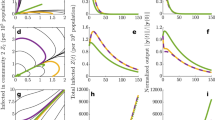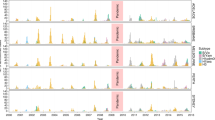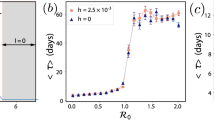Abstract
Seasonality is a driving force that has a major effect on the spatio-temporal dynamics of natural systems and their populations1,2,3,4,5. This is especially true for the transmission of common infectious diseases (such as influenza, measles, chickenpox and pertussis), and is of great relevance for host–parasite relationships in general1,2,3,4,5,6,7,8,9,10,11,12,13,14,15,16,17,18,19,20,21,22,23. Here we gain further insights into the nonlinear dynamics of recurrent diseases through the analysis of the classical seasonally forced SIR (susceptible, infectious or recovered) epidemic model6,7. Our analysis differs from other modelling studies in that the focus is more on post-epidemic dynamics than the outbreak itself. Despite the mathematical intractability of the forced SIR model, we identify a new threshold effect and give clear analytical conditions for predicting the occurrence of either a future epidemic outbreak, or a ‘skip’—a year in which an epidemic fails to initiate. The threshold is determined by the population’s susceptibility measured after the last outbreak and the rate at which new susceptible individuals are recruited into the population. Moreover, the time of occurrence (that is, the phase) of an outbreak proves to be a useful parameter that carries important epidemiological information. In forced systems, seasonal changes can prevent late-peaking diseases (that is, those having high phase) from spreading widely, thereby increasing population susceptibility, and controlling the triggering and intensity of future epidemics. These principles yield forecasting tools that should have relevance for the study of newly emerging and re-emerging diseases controlled by seasonal vectors.
This is a preview of subscription content, access via your institution
Access options
Subscribe to this journal
Receive 51 print issues and online access
$199.00 per year
only $3.90 per issue
Buy this article
- Purchase on Springer Link
- Instant access to full article PDF
Prices may be subject to local taxes which are calculated during checkout




Similar content being viewed by others
References
Anderson, R. M. & May, R. M. Infectious Diseases of Humans: Dynamics and Control (Oxford Univ. Press, New York, 1991)
Pascual, M. & Dobson, A. Seasonal patterns of infectious diseases. PLoS Med. 2, 18–19 (2005)
Altizer, S. et al. Seasonality and the dynamics of infectious diseases. Ecol. Lett. 9, 467–484 (2006)
London, W. P. & Yorke, J. A. Recurrent outbreaks of measles, chickenpox and mumps. 1. Seasonal variation in contact rates. Am. J. Epidemiol. 98, 453–468 (1973)
Fine, P. E. M. & Clarkson, J. A. Measles in England and Wales-I: An analysis of factors underlying seasonal patterns. Int. J. Epidemiol. 11, 5–14 (1982)
Earn, D. J. D., Rohani, P., Bolker, B. M. & Grenfell, B. T. A simple model for complex dynamical transitions in epidemics. Science 287, 667–670 (2000)
Keeling, M., Rohani, P. & Grenfell, B. T. Seasonally forced disease dynamics explored as switching between attractors. Physica D 148, 317–335 (2001)
Bjornstad, O. N., Finkenstadt, B. F. & Grenfell, B. T. Dynamics of measles epidemics: estimating scaling of transmission rates using a time series SIR model. Ecol. Monogr. 72, 169–184 (2002)
Finkenstadt, B. F. & Grenfell, B. T. Time series modelling of childhood diseases: a dynamical system approach. Appl. Stat. 49, 187–205 (2000)
Olsen, L. F., Truty, G. L. & Schaffer, W. M. Oscillations and chaos in epidemics: a nonlinear dynamic study of six childhood diseases in Copenhagen, Denmark. Theor. Pop. Biol. 33, 344–370 (1988)
Schwartz, I. B. & Smith, H. L. Infinite subharmonic bifurcation in an SEIR epidemic model. J. Math. Biol. 18, 233–253 (1983)
Aron, J. L. & Schwartz, I. B. Seasonality and period-doubling bifurcations in an epidemic model. J. Theor. Biol. 110, 665–679 (1984)
Bolker, B. M. & Grenfell, B. T. Chaos and biological complexity in measles dynamics. Proc. R. Soc. Lond. B 251, 75–81 (1993)
Billings, L. & Schwartz, I. B. Exciting chaos with noise: unexpected dynamics in epidemic outbreaks. J. Math. Biol. 44, 31–48 (2002)
Andreasen, V. Dynamics of annual influenza A epidemics with immuno-selection. J. Math. Biol. 46, 504–536 (2003)
Casagrandi, R., Bolzoni, L., Levin, S. A. & Andreasen, V. The SIRC model and influenza A. Math. Biosci. 200, 152–169 (2006)
Dietz, K. The incidence of infectious diseases under the influence of seasonal fluctuations. Lect. Notes Biomath. 11, 1–15 (1976)
Engbert, R. & Drepper, F. R. Chance and chaos in population biology – models of recurrent epidemics and food chain dynamics. Chaos Solitons Fractals 4, 1147–1169 (1994)
Olsen, L. F. & Schaffer, W. M. Chaos versus noisy periodicity: alternative hypotheses for childhood epidemics. Science 249, 499–504 (1990)
Rand, D. A. & Wilson, H. B. Chaotic stochasticity: a ubiquitous source of unpredictability in epidemics. Proc. R. Soc. Lond. B 246, 179–184 (1991)
Schaffer, W. M. & Kot, M. Nearly one dimensional dynamics in an epidemic. J. Theor. Biol. 112, 403–427 (1985)
Dushoff, J., Plotkin, J. B., Levin, S. A. & Earn, D. J. D. Dynamical resonance can account for seasonality of influenza epidemics. Proc. Natl Acad. Sci. USA 48, 16915–16916 (2004)
Shulgin, B., Stone, L. & Agur, Z. Pulse vaccination strategy in the SIR epidemic model. Bull. Math. Biol. 60, 1123–1148 (1998)
Huppert, A., Blasius, B., Olinky, R. & Stone, L. A model for seasonal phytoplankton blooms. J. Theor. Biol. 236, 276–290 (2005)
Finkenstadt, B. F. & Grenfell, B. T. Empirical determinants of measles metapopulation dynamics in England and Wales. Proc. R. Soc. Lond. B 265, 211–220 (1998)
Sugihara, G. & May, R. M. Nonlinear forecasting as a way of distinguishing chaos from measurement error in time-series. Nature 344, 734–741 (1990)
Murray, J. D. Mathematical Biology 2nd edn (Springer, Berlin, 1989)
Olinky, R., Huppert, A. & Stone, L. Thresholds in seasonally forced epidemiological models. Proc. Natl Acad. Sci. USA (submitted).
Madden, L. V. & Van den Bosch, F. A population-dynamics approach to assess the threat of plant pathogens as biological weapons against annual crops. Bioscience 52, 65–74 (2002)
Morens, D. M., Folker, G. K. & Fauci, A. S. The challenge of emerging and re-emerging infectious diseases. Nature 430, 242–249 (2004)
Acknowledgements
We are grateful for the support of the James S. McDonnell Foundation. A.H. was partly supported by the Porter School of Environmental Studies at Tel Aviv University.
Author information
Authors and Affiliations
Corresponding author
Ethics declarations
Competing interests
Reprints and permissions information is available at www.nature.com/reprints. The authors declare no competing financial interests.
Supplementary information
Supplementary Information
This file contains Supplementary Notes, Supplementary Figures 1-8 with Legends and additional references. (PDF 407 kb)
Rights and permissions
About this article
Cite this article
Stone, L., Olinky, R. & Huppert, A. Seasonal dynamics of recurrent epidemics. Nature 446, 533–536 (2007). https://doi.org/10.1038/nature05638
Received:
Accepted:
Issue Date:
DOI: https://doi.org/10.1038/nature05638
This article is cited by
-
A mathematical interpretation for outbreaks of bacterial meningitis under the effect of time-dependent transmission parameters
Nonlinear Dynamics (2023)
-
Social Pressure from a Core Group can Cause Self-Sustained Oscillations in an Epidemic Model
Acta Biotheoretica (2023)
-
A stochastic model explains the periodicity phenomenon of influenza on network
Scientific Reports (2021)
-
Mechanisms of recurrent outbreak of COVID-19: a model-based study
Nonlinear Dynamics (2021)
-
Global Dynamics of a Susceptible-Infectious-Recovered Epidemic Model with a Generalized Nonmonotone Incidence Rate
Journal of Dynamics and Differential Equations (2021)
Comments
By submitting a comment you agree to abide by our Terms and Community Guidelines. If you find something abusive or that does not comply with our terms or guidelines please flag it as inappropriate.



